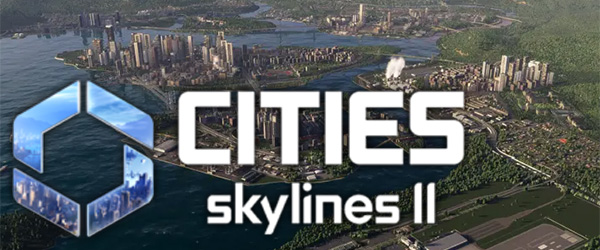
I've been playing Cities: Skylines for almost 10 years. As soon as I started playing it, I recognized it as the definitive city-building game. It blew its contemporaries, such as SimCity (2013) and Cities XL out of the water. It was a smash success that developed a massive following and spawned 11 full expansions, 4 mini-expansions, 21 asset packs, numerous music packs, and thousands of player-created mods and custom assets.
Creating a sequel to a game that is so beloved and content-rich can be challenging or daunting. Sequels to extensively-expanded games, such as any given entry of The Sims, Civilization, Crusader Kings, World of Warcraft, Rock Band, and so forth, run the extreme risk of feeling bland, empty, and incomplete compared to their content-rich and/or mechanically-complex predecessors. This can leave the sequel feeling underwhelming to long-time audiences, who might return to the older game because they crave the extensive, familiar content. The Sims in particular is infamous for stripping out popular expansion content, and then selling that content back to consumers again (and again) as an expansion pack for the sequel. The most notable example is probably that every Sims game has a "Pets" expansion, because EA could never bite the bullet and just put dogs and cats in the vanilla launch of a sequel.
Sequels to expanded games often strip out popular content to re-sell as expansions.
The sequel to Cities: Skylines is a bit of a mixed bag in this regard. On the one hand, yeah, a lot of content from the original game is absent from the sequel, and the options for what players can build can feel a bit sparse. On the other hand, the vanilla release of Cities: Skylines II retains something from almost every one of the original game's expansions. It even includes content and mechanics that were part of some of the smaller content packs and from popular mods.
The vanilla game includes a day/night cycle that was introduced in the original's After Dark expansion. Some of the economic models of the After Dark and Industries expansions have been expanded in scope to apply to the entire game, thus alleviating some of the need for explicit tourism, leisure, or specialized industry districts. It took the winter themes of Snowfall and fleshed it out into a full seasonal cycle. It includes some of the weather and disaster events from Natural Disasters, as well as some of the early-warning and shelter infrastructure. It includes modular upgrades and customizations to certain buildings and infrastructure, as well as large industrial areas, that fills a similar role as the modular areas of Parklife, Industries, Campus, and Airports (though I'll talk more about this mechanic later in the review). It includes pedestrian roads from Plazas & Promenades. It includes eco-friendly variations of utilities that were part of the Green Cities expansion. And of course, it has road-building and transit-planning tools that largely leave Mass Transit in the dust.
It even includes sports parks and parking lots, which were late DLC content released for the original game in the last couple years. And the road-building and traffic-management tools have much of the functionality from the popular "Road Anarcy" and "Network Extension" mods. And that's to say nothing of all the brand new content, mechanics, and more complicated simulation! So even though it is not as full or content-rich as its predecessor with its double-digit expansions (how could it be?!), Cities: Skylines II is still a fully-featured and content-rich city-builder that can be played for many hours before going stale.
Some content and mechanics from almost every CS1 expansion are included in CS2's launch.
But as I said, there is quite a lot of content from the original game that did not make the cut, and which is sorely missed. For one thing, bicycles and bike lanes aren't in the game at launch, which is a kind of baffling decision (considering this game is developed in Scandinavia, where bicycling is huge). There also aren't any walls or fences or quays, and the tool for disabling zoning on either side of a road is strangely absent. So it's back to using pedestrian paths to remove zoning from arterial roads. Zoning is actually quite a bit of a pain in the ass in the sequel, and I am frequently fighting with the road layout, zoning squares, and pedestrian paths to try to get my city to look the way I want.
If you were particularly fond of leveling up and expanding things like industrial parks, nature preserves, amusement parks, universities, and so forth, then you might be disappointed by their absence. In fact, recreation, leisure, and tourism options are very spares in the sequel, as it lacks the tourism and leisure districts of the After Dark expansion. You also won't be building any small fishing villages, since Sunset Harbor is the one expansion that doesn't have anything being carried over into the sequel.
To its credit, the vanilla release of Cities: Skylines II feels more content rich and mechanically-compelling compared to the vanilla release of the original Cities: Skylines. But there's so much absent from the original game, that I un-install the original from my PC with a degree of trepidation.
There is some content from CS1 that is conspicuously absent. [More]
a2c0f15c-0983-4034-a8e5-7561b2c76190|0|.0
Tags:Cities: Skylines, Cities: Skylines 2, Colossal Order, Paradox Interactive, city, city management, city simulation, seasons, industry, parking, tourism, poverty, homelessness, welfare, subsidies, ray-tracing, volumetric lighting, Sedona, Barstow
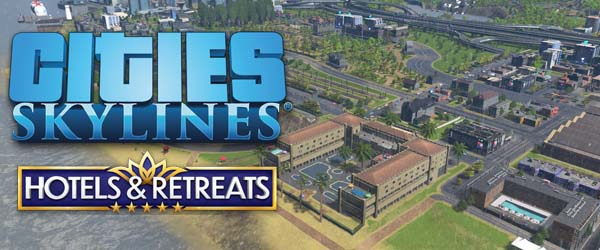
Surely this has to be the last DLC that Cities: Skylines is receiving, given that the sequel is due out this fall. This last wave of expansions and content creator packs has scratched a lot of very specific itches that I've had with Cities: Skylines for a long time, and they've had me playing the game a lot lately. I've been building a large city up over 100 thousand population, and also going back to some older save files and either upgrading them to use newer DLC assets, or to replace old mod assets with analogous official DLC assets.
A near seamless fit
What I really like about Hotels & Retreats is how seamlessly they fit into the existing game. Like with Industries, Campus, and Airports, I feel that Hotels & Retreats could easily have fallen into the trap of replacing old assets and rendering them moot or useless. Like, if the DLC had added a "resort area" mechanic using the Parklife area painting mechanic with modular hotels and resorts, it could easily have caused me to stop using the After Dark leisure and tourism district specializations (just like I've basically stopped using farm, forestry, oil, and ore industry specializations because I use the Industries areas instead).
Hotels & Retreats works very well alongside other expansion content!
Instead of feeling like a replacement for the existing tourism districts, the content of Hotels & Retreats is a great supplement. In fact, it feels like it could easily have been part of the After Dark expansion. Or the Parklife expansion. Or the Airports expansion. Or Plazas & Promenades. Or even the previous Financial Districts DLC.
Each hotel has preferences for proximity to a combination of city landmarks, shopping, offices, or nature. How well the hotel's location fits its unique combination of those 4 preferences will determine how popular it is for guests, which in turn will influence how much (if any) profit it makes, and the player can set its pricing accordingly. A business hotel placed in the middle of an IT or financial specialty district, along with some nearby commercial districts, will generate high profit; while a rental cabin will do best if placed in the vicinity of a nature preserve, in the middle of a forest, or along a pristine scenic coastline.
Each individual hotel's profit is aggregated into a total profit margin for the "chain" of hotels, and higher-level hotels are unlocked by increasing the weekly profit of the entire chain. So improperly-placed or poorly-performing hotels can be subsidized by the fully-occupied, perfectly-placed hotels with higher prices and profit margins.
Cheap, unprofitable niche hotels can be subsidized by the more popular and expensive hotels.
[More]
8424b6e9-a9f1-4b73-bdc8-0f5de5b5d48b|0|.0
Tags:Cities: Skylines, Cities: Skylines: Hotels and Retreats, hotel, resort, beach, park, tourism, roads, Cities: Skylines: Parklife, Cities: Skylines: Industries, Cities: Skylines: Natural Disasters
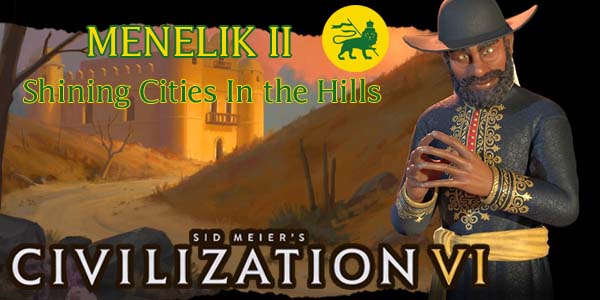
Firaxis recently released the second civilization and leader pack for its New Frontiers DLC Pass. This pack includes alternate versions of the leaders Teddy Roosevelt and Catherine de Medicci, and the new Secret Societies game mode. The main part of the new DLC, however, is the new civilization, Ethiopia, lead by Menelik II. I expect to have the guide for Lady Six Sky of the Maya published within the next couple of weeks. In the meantime, a preview of the Maya guide is already available to my Patrons via Patreon.
Paleontologists believe that Ethiopia was one of the earliest homes of anatomically modern homo sapiens, and that humans crossed through Ethiopia on their way to the Middle East and Asia. Ethiopia is the source for some of the oldest known examples of stone-tipped human weapons and tools, dated at 279,000 years old. Ruins in Bale Mountains suggest the earliest known example of permanent human residence at high altitudes. The earliest kingdoms in Ethiopia were founded out of Semetic traditions, and the region has been heavily influenced by both Islam and Christianity, making Ethiopia a unique melting pot for all three of the Abrahamic religions. Ethiopia and Liberia were the only two African nations to retain their sovereignty during the European colonizations of Africa, and held off an invasion from colonial Italy in 1896 before eventually being conquered by fascist Italy in the lead-up to World War II.

Emperor Menelik II helped to modernize Ethiopia, and also establish Ethiopia as an independent nation after defeating the first Italian invasion in 1896. Menelik II went on to expand Ethiopia's territory and established a Council of Ministers that served long after his death and advised at least two other emperors (and conspired to depose one of them). He adopted a strict prohibition of the slave trade within Ethiopia, and is fondly remembered by the people of Ethiopia for his tremendous benevolence to the poor.
DISCLAIMER:
Civilization VI is still a "living game". Strategies for the game (and for specific leaders and civs) may change as Firaxis applies balance patches, introduces new features, or expands the game through further DLC or expansion packs, or as the Civ community discovers new strategies or exploits. As such, the following strategy guide may change from time to time. I will try to keep it up-to-date, and will make notations whenever changes are made. I'll also post links in the official 2K forums and CivFanatics, where I'll also report any changes made. If possible and practical, I will try to retain the original content of the strategy for posterity.
I welcome any feedback or suggestions that readers wish to offer. Feel free to post on the linked forums, or by posting a comment at the bottom of the page.
This guide is up to date as of the release of the "New Frontiers" Ethiopia DLC pack (July 2020) (ver. 1.0.3.31)
Ethiopia likes to build its cities in the hills. Doing so grants access to the Rock-Hewn church, which grants faith from adjacent hills and mountains. A portion of Ethiopia's hill-folk faith will be converted to science and culture. [More]
71bcd05b-0c24-4591-ace6-ddfc06d3e3e3|0|.0
Tags:Sid Meier's Civilization, Civilization VI, Ethiopia, Menelik II, Aksumite Legacy, council of ministers, rock-hewn church, oromo cavalry, Ethiopian highlands, hill, faith, religion, culture, tourism, volcano, natural disaster, resource
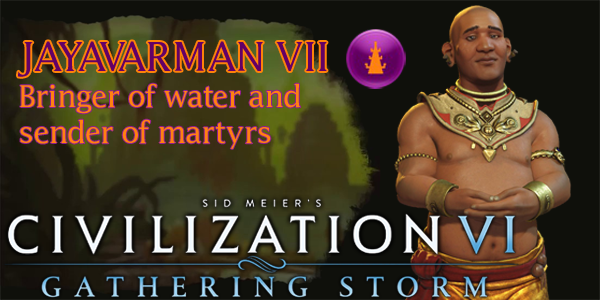
Civilization VI's third expansion, Gathering Storm recently released and has added a handful of new civilizations and leaders. I am hoping to write a strategy for each of them, but I also want to continue to write guides for the civilizations that were already in the game. I put up a poll on my Patreon page for my patrons to vote on which civ(s) they would like to see. The three top vote-getters (from all the three people who voted) were Khmer, Aztec, and Norway. It's been a while since I've done a strategy for a religion-oriented civ, so I thought I'd do a strategy for Jayavarman VII of the Khmer. The Khmer were present as a playable civilization in Civilization IV's Beyond the Sword expansion, but they were not present in Civilization V. They appeared as a DLC civ prior to Rise & Fall's release, but this strategy should work for players of the new Gathering Storm expansion as well.
The city of Angkor, the capital of the Angkor Empire (also called the Khmer Empire), is believed to be the largest pre-industrial urban center in the world, stretching for roughly 400 square miles and housing roughly 0.1% of the entire global population at its zenith. This empire controlled most of mainland southeast Asia from the ninth century CE to the 15th century CE, reaching its zenith between the 11th and 13th centuries. Many impressive ruins still stand in the site of Angkor, and many have been restored by local archaeological organizations and UNESCO, including the impressive Angkor Wat, the largest single religious monument in the world. Satellite imagery has also revealed an intricate network of irrigation channels which were likely used to manage the regions unpredictable monsoons, as well as to support the population.

Around 1150 CE, the kingdom of Angkor was invaded by the neighboring Cham empires, who succeeded at toppling the capital. General Mahaparamasaugata (believed to already be over the age of 60) lead a successful campaign to push the Cham out of the Khmer capital, and he ascended to the throne in order to continue the war and conquer much of the Champa territory. He relocated the capital to Angkor Thom, where large monuments were constructed in his honor, including the temple of Bayon. He went on to re-unify the empire, building a network of roads connecting every major town, complete with rest-houses every 9 miles and hospitals for travelers. He reigned successfully until his death at the impressively-ripe old age 97 or 98, and is regarded as the last great king of Cambodia. He was posthumously re-named Jayavarman VII, after a line of Cambodia's greatest kings.
DISCLAIMER:
Civilization VI is still a "living game". Strategies for the game (and for specific leaders and civs) may change as Firaxis applies balance patches, introduces new features, or expands the game through further DLC or expansion packs, or as the Civ community discovers new strategies or exploits. As such, the following strategy guide may change from time to time. I will try to keep it up-to-date, and will make notations whenever changes are made. I'll also post links in the official 2K forums and CivFanatics, where I'll also report any changes made. If possible and practical, I will try to retain the original content of the strategy for posterity.
I welcome any feedback or suggestions that readers wish to offer. Feel free to post on the linked forums, or by posting a comment at the bottom of the page.
This guide is up to date as of the release of the Gathering Storm expansion (ver. 1.0.0.314) (Antarctic Late Summer Patch, April 2019)
Khmer is a strong religious civ who gets extra food from Holy Sites, and extra faith from Aqueducts, as well as other bonuses to food and amenity. It can build and support large populations in its cities, and gets relics from its missionaries and apostles much more frequently, which can contribute to a culture victory.
... [More]
3a7fbd1d-fdc3-49c8-a0b2-e222656249c4|2|3.5
Tags:Sid Meier's Civilization, Civilization VI, Civilization VI: Gathering Storm, Khmer, Jayavarman VII, Grand Barays, monasteries of the king, domrey, prasat, temple, aqueduct, farm, food, holy site, missionary, apostle, religion, relic, culture, tourism, DLC, Patreon, unique building, unique siege unit
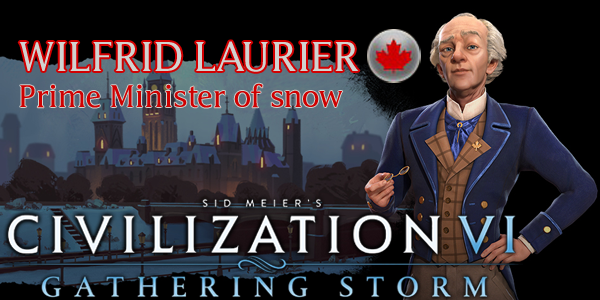
Civilization VI's second expansion, Gathering Storm recently released and has added a handful of new civilizations and leaders. I am hoping to write a strategy for each of them, but I want to start with the civilizations and leaders who are completely new to the franchise.
One of these new civs represents a sort-of "farewell" present to the founder and former lead-host of the PolyCast podcast, Dan Q, who stepped down from the podcast at the end of 2018 in order to spend more time with his new family. However, he'll still be playing Civ, and for the first time in the franchise's history, Dan gets to play as his home and native land of Canada. It's too bad he's not on PolyCast anymore to tell us about how great Wilfrid Laurier of Canada is, eh?

On a more serious note: thank you, Dan for over a decade of faithful service and dedication to the Civilization community. And on a more personal note, thank you for inviting me to join the regular panel on PolyCast. You gave me a voice within this community that I did not think I would ever be able to reach. We'll miss you, Dan, and we hope to talk to you again as a guest host many times in the future. Best wishes to you and your new wife in your new life together. May your lives together be forever in a Golden Age!
This guide is dedicated to you, Dan. Now let's talk about Canada in Civilization VI!

The first European colony in North America is widely accepted to be a Norse encampment in Newfoundland, which was abandoned within a few years of settlement. It wasn't until the 16th century that large-scale colonization began -- mostly by French and British colonists. In 1763, France ceded most of its North American colonies to the British following years of on-again-off-again warfare. The Confederation of Canada was formed over a hundred years later, but remained loyal to the British crown until the Canada Act of 1982. Despite being a formally independent nation, Canada still maintains the British monarch (currently Queen Elizabeth II) as its official head of state. Because many of the founding cities were French colonies, Canada is an officially bilingual country, with both English and French being its official languages, and it is now one of the most multi-cultural nations in the world due to frequent large-scale immigration from other parts of the world. Canadian interactions with indigenous peoples were generally less violent than with neighboring United States' interactions with natives. However, the expansion of Canadian territory still required the forced relocation or assimilation of somewhere between 200,000 and 2 million indigenous peoples, including the Inuit, Métis, the Cree, and several dozen other tribes.
Canada's first French-speaking prime minister was Sir Henri Charles Wilfrid Laurier. Laurier was part of Canada's Liberal party, advocating for decentralized federalism and staunchly defending individual personal liberty. Despite wishing for Canada to remain an autonomous nation loyal to the British Empire, he would go on to oppose British conscription of Canadian citizens in World War I, which would become a polarizing issue in the early 20th century. He gained a reputation as a bright and cheerful leader who always followed the "sunny ways", and has become one of the most beloved prime minsters in Canadian history.
DISCLAIMER:
Civilization VI is still a "living game". Strategies for the game (and for specific leaders and civs) may change as Firaxis applies balance patches, introduces new features, or expands the game through further DLC or expansion packs, or as the Civ community discovers new strategies or exploits. As such, the following strategy guide may change from time to time. I will try to keep it up-to-date, and will make notations whenever changes are made. I'll also post links in the official 2K forums and CivFanatics, where I'll also report any changes made. If possible and practical, I will try to retain the original content of the strategy for posterity.
I welcome any feedback or suggestions that readers wish to offer. Feel free to post on the linked forums, or by posting a comment at the bottom of the page.
This guide is up to date as of the release of the Gathering Storm expansion (ver. 1.0.0.290)
Canda is a prime contender for a turtle strategy, as it cannot surprise declare on other civs, or be surprise declared on. They also specialize in settling in otherwise-inhospitable tundra.
... [More]
504f5955-2cb6-4f67-90d0-584dee7a227e|0|.0
Tags:Sid Meier's Civilization, Civilization VI, Civilization VI: Gathering Storm, Canada, Wilfrid Laurier, four faces of peace, the last best west, tundra, hockey, hockey rink, farm, mountie, national park, tourism, culture, world congress, diplomatic favor, unique improvement, unique mounted unit
|

| 12 | | | | | | | 60 | | 11 | | | | | | | 55 | | 10 | | | | | | | 50 | | 09 | | | | | | | 45 | | 08 | | | | | | | 40 | | 07 | | | | | | | 35 | | 06 | | | | | | | 30 | | 05 | | | | | | | 25 | | 04 | | | | | | | 20 | | 03 | | | | | | | 15 | | 02 | | | | | | | 10 | | 01 | | | | | | | 05 |
|